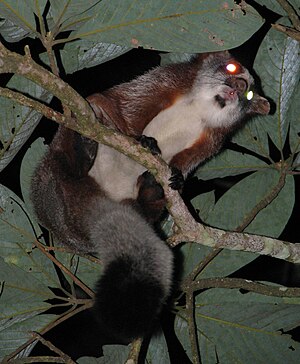Taguan
| Taguan | ||||||||||||
|---|---|---|---|---|---|---|---|---|---|---|---|---|

Taguan ( Petaurista petaurista ) |
||||||||||||
| Systematics | ||||||||||||
|
||||||||||||
| Scientific name | ||||||||||||
| Petaurista petaurista | ||||||||||||
| ( Pallas , 1766) |
The Taguan ( Petaurista petaurista ) is a rodent belonging to the genus of the giant flying squirrel . He lives in dense forest areas in Asia - from Kashmir to southern China, on Sri Lanka , Borneo and Java .
features
Compared to other squirrels, the Taguan is relatively large with an average head-trunk length of around 40 centimeters, and its tail has an average length of 42 centimeters. The body weight averages 1750 grams. The body color varies regionally, usually the animals have a reddish-brown fur and a light belly.
The Taguan has a large and hairy flight membrane that connects the wrists and ankles and is enlarged by a fold of skin between the hind legs and the base of the tail. The flight membrane is muscular and reinforced at the edge, it can be tensed and relaxed accordingly in order to control the direction of gliding. The front feet have four fingers and the rear feet have five toes.
distribution and habitat
The Taguan has a very large Asian distribution area, which includes northern South Asia, southern China and parts of Southeast Asia . In South Asia, the species occurs in eastern Afghanistan , northern Pakistan and India , Bhutan , Nepal and eastern Bangladesh . In China, it has been documented in Yunnan , Sichuan , Fujian , Guangxi, and Guangdong provinces . The Southeast Asian distribution extends over Myanmar and Thailand and over the Malay Peninsula to Indonesia on the islands of Sumatra , Java and Borneo . A first record of a Taguan for Laos at a meat market in the area of Thatlouang comes from the year 2014, it is the most easterly place where the species was found.
The altitude distribution extends especially in the area of the Himalayas in northern India up to an altitude of 3,100 meters. The animals live mainly in various forest areas, including evergreen deciduous forests as well as coniferous and scrub forests. They also occur in rocky areas with less vegetation.
Way of life
Taguanas are nocturnal and have their main activity times in the early evening. They feed on cones, small twigs, young leaves and flower buds; nuts and fruits are added seasonally. During the day they hide in hollow trees to look for food at dusk. The animals are good climbers and they are able to perform long gliding flights of up to 75 meters. To do this, they jump from high positions, usually tree tops or high branches, and control the flight over the muscular flight membrane. While resting, they fold the flight membrane and keep it close to the body.
The animals live alone, in pairs or in family groups; not much is known about their reproduction. Apparently the females throw two to three young animals per litter twice a year, in March and August, in a specially built nest. In captivity, the animals can reach an age of up to 16 years.
Although the areas where the Taguan occurs can sometimes get very cold in winter, they do not hibernate . However, it is believed that they move to areas with greater food supply.
Systematics
The Taguan is one of currently eight species in the genus of the giant flying squirrel ( Petaurista ). Wilson & Reeder 2005 distinguish a total of 18 subspecies, whereby the Petaurista philippensis , which is now regarded as a separate species, was originally also a subspecies. A revision is proposed for the species as it is believed to be a combination of several very similar species.
Threat and protection
The species is classified by the International Union for Conservation of Nature and Natural Resources (IUCN) as not endangered (least concern) due to the size of the population and the large distribution area. The population is declining locally, mainly due to habitat changes and the conversion of forest areas into agriculturally used areas. However, the species occurs in several protected areas in which no decline in populations is to be expected.
supporting documents
- ^ A b c d e Sarah Newlin, James Bradshaw: Petaurista petaurista in the Animal Diversity Net.
- ↑ a b c d e Petaurista petaurista in the endangered Red List species the IUCN 2011. Posted by: J. Walston, JW Duckworth, SU Sarker, p Molur, 2008. Accessed May 23, 2012 found.
- ↑ Daosavanh Sanamxay, Bounsavane Douangboubpha1, Sara Bumrungsri, Chutamas Satasook, Paul JJ Bates: A summary of the taxonomy and distribution of the red giant flying squirrel, Petaurista petaurista (Sciuridae, Sciurinae, Pteromyini), in mainland record from Southeast Asia with the first Lao PDR. Mammalia, August 2014. doi : 10.1515 / mammalia-2014-0005 .
- ^ A b Petaurista petaurista In: Don E. Wilson , DeeAnn M. Reeder (Ed.): Mammal Species of the World. A taxonomic and geographic Reference. 2 volumes. 3. Edition. Johns Hopkins University Press, Baltimore MD 2005, ISBN 0-8018-8221-4 .
Web links
- Petaurista petaurista in the endangered Red List species the IUCN 2011. Posted by: J. Walston, JW Duckworth, SU Sarker, p Molur, 2008. Accessed May 23, 2012 found.

